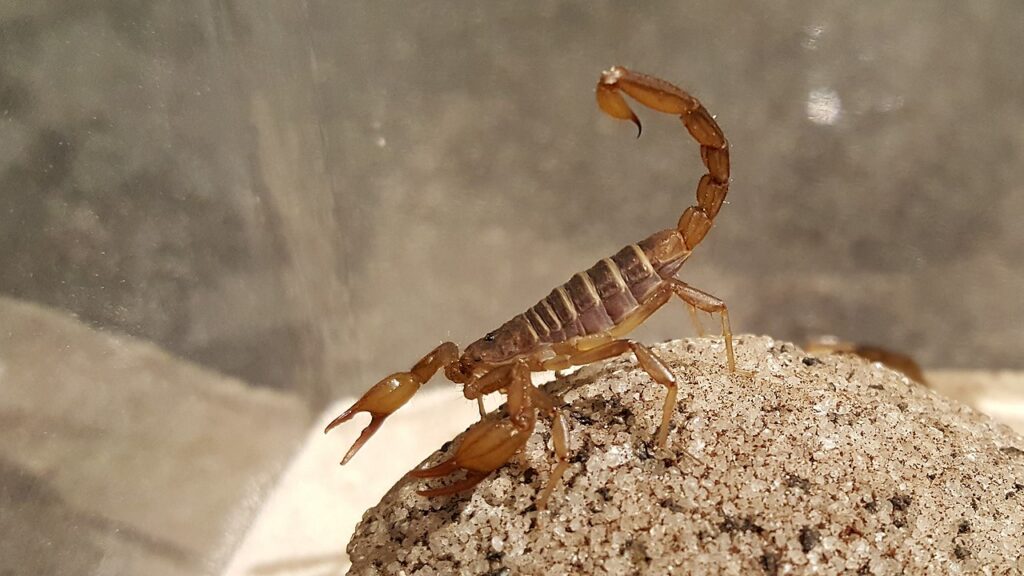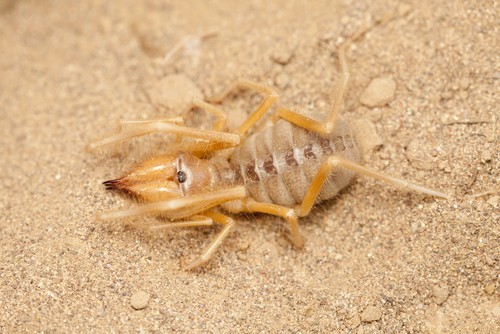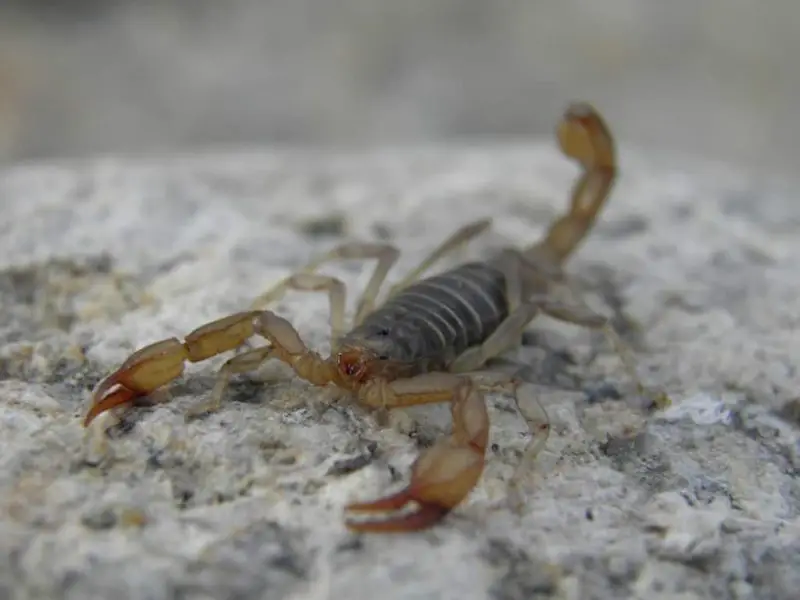When you think of scorpions, I bet you think of sandy hot deserts far south of Canada. Alberta probably isn’t the first area of the world that comes to mind. There are over 70 scorpion species in North America. All of them but one are incapable of living through a Canadian winter. The one true scorpion species that lives in Alberta is the Northern scorpion. Pseudoscorpions and wind scorpions also live in Alberta. We’ll talk about all three of these arachnids.
The Northern Scorpion (Paruroctonus boreus)
The northern scorpion or boreal scorpion is a species of scorpion in the family Vaejovidae. It is the only species of scorpion found in Canada. It, along with hobo spiders and black widow spiders, make up Canada’s three venomous arachnids.
Northern scorpions are found in 12 U.S. states and 3 Canadian provinces. The northern scorpion species range begins in northern Arizona and goes north to southwestern Canada. The U.S. states that have Northern scorpions are Arizona, California, Nevada, Utah, Idaho, Wyoming, Montana, North Dakota, South Dakota, Oregon, and Washington. In Canada, Northern Scorpions live in southern British Columbia, southern Alberta, and southern Saskatchewan. See
Where to find northern scorpions in Alberta
If you’re out looking for a northern scorpion, take caution. Remember that they have a venom-packed stinger. When they sting humans, the effects generally aren’t any more serious than a bee sting. However, all stings have the potential to cause mild to severe allergic reactions.
Also, take note that the prairie rattlesnake inhabits most of the same territory as the northern scorpion in Alberta. Pay attention to where you place your feet and hands.
Although there has never been anyone killed by a rattlesnake bite in Alberta, a bite from a prairie rattler is quite a bit more dangerous than a sting from a northern scorpion.
The range of the northern scorpion reaches up to 52 degrees north latitude. In Alberta, this is just below Red Deer.
In Alberta, the best place to look for them is on dry, eroded riverbank slopes. Generally, you won’t find them on north-facing slopes, though. Look for them on southwest-facing slopes instead. They prefer to inhabit cracks in sandstone or shale or the cavities beneath surface stones. They also take shelter beneath fallen logs.
In Alberta, northern scorpions live in the valleys of the Oldman River, the St. Mary River, the Milk River, and the South Saskatchewan River. They also live along the Red Deer River between Drumheller and Jenner, and also from Jenner east to Empress on the Alberta-Saskatchewan border.
Along the South Saskatchewan River, Northern Scorpions are most numerous in close proximity to Medicine Hat. They become more so during dry periods when their food sources, such as grasshoppers, become more numerous.
The coulees of Lethbridge leading down to the Old Man River hold both northern scorpions and prairie rattlesnakes. What’s more, the tourists visiting the Fort Whoop-Up historical site near Lethbridge may, by chance, encounter either one of these venomous critters.

What do northern scorpions look like?
Scorpions look a little bit like tiny land-dwelling lobsters with some distinctions. Lobsters have 10 legs, while scorpions have 8, and of course, lobsters don’t have a bulbous stinger on the end of their tail, while scorpions do.
Northern scorpions have segmented sections in their exoskeletons that range in color from light brown to dark brown. What’s more, they have proportionately long tails with a stinger on the tip and two lobster like front pinchers that do not function as legs. In size, an adult northern scorpion will be 35mm to 55mm (1.37 to 2.16 inches) long.
Like most scorpions, northern scorpions have fluorescent compounds in their exoskeletons that make them glow under UV light. If you are camping in an area where northern scorpions are active, it’s a good idea to go armed with an ultraviolet flashlight to scan your campsite after dark. Like all scorpions, northern scorpions are nocturnal creatures. As such, they will be out and about after dark, searching for small prey such as grasshopper nymphs.

Pseudoscorpions in Alberta
Pseudoscorpions, also sometimes called book scorpions or false scorpions, are tiny arachnid species that look a lot like a tiny scorpion minus the stinger. They have a flat, pear-shaped body, eight legs, and two long pedipalps with pinchers on the ends, just like scorpions.
As stated above, these are tiny little creatures that are often mistaken for ticks. There are over 3,300 pseudoscorpion species worldwide, and their average body length is just 3 millimeters.
Book scorpions don’t have a stinger on their tail. However, they do have a stinger in each pincher. They inject their prey with venom to immobilize it. After which, they secrete a fluid over it to dissolve it so that they can ingest the liquified remains.
Book scorpions are generally beneficial to humans since they prey on pests such as clothes moth larvae, carpet beetle larvae, booklice, ants, mites, and small flies. See

Wind scorpions in Alberta
Another interesting arachnid that you might run across in southern Alberta is the wind scorpion. Wind scorpions are also sometimes called sun spiders or camel spiders. These creatures have strong jaws that are capable of delivering a nasty bite. However, they are not venomous. They look like a cross between a spider and a scorpion, but they are actually neither. They are an arachnid, but they are from the order sollifugae. There are more than 1000 sollifugae species that live in Asia, Africa, the Americas, and southern Europe. See
In Canada, there are possibly 6 different sollifugae species that haven’t been scientifically described yet. They are found in British Columbia, Alberta, and Saskatchewan.
In North America, most wind scorpion species are nocturnal. They spend the daylight hours in shallow burrows, under rocks, wood debris, or dried cattle dung. They are extremely quick, aggressive predators that feed on anything they can catch. See
Recent Posts
The only venomous snakes in Washington State are Northern Pacific Rattlesnakes. The Northern Pacific Rattlesnake (Crotalus oreganus oreganus) is a sub-species of the Western Rattlesnake. Anyone...
Skunks are not classified as true hibernators. But they go into a state of torpor when the weather gets cold. Skunks are light sleep hibernators, along with opossums, bears, and raccoons. ...

